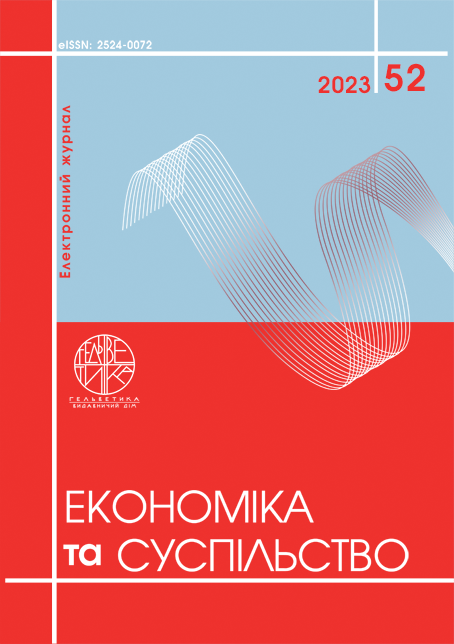BUSINESS COMMUNICATIONS IN THE SYSTEM OF SCIENTIFIC RESEARCH
Abstract
The article discusses the current problems of ensuring the effectiveness of business communications in the field of conducting scientific research in modern conditions. It was determined that productive interaction between scientists, teachers, students and other members of the scientific community requires an effective exchange of information, ideas and research results. The importance of business communications in the system of scientific research and their significant impact on the scientific process in the conditions of the growth of technical capabilities of establishing communications are proven. The key aspects of the business communication system in the context of scientific research are analyzed, including such aspects as interactivity, collaboration, dissemination of results and development of cooperation. It was determined that successful scientific research should involve the establishment of active interaction between all researchers. At the same time, communication channels must be open and accessible to ensure the facilitation of the exchange of ideas and knowledge between different participants. It has been proven that in the process of scientific research, their participants must be able to work together, combining their knowledge and expertise to achieve common goals, as effective business communications stimulate the formation of scientific teams that maximize their potential. It is determined that in order to achieve recognition and influence in the scientific field, it is necessary to be able to effectively present the results of research, therefore, appropriate communication skills help researchers present their discoveries to a wide audience, including specialists and the public. The need for the effective formation of business communications to promote the development of scientific communities and a network of connections between research participants is formulated, since it is thanks to the active exchange of ideas that scientists can discover new scientific directions and contribute to the emergence of innovative projects. It has been proven that business communication is a necessary tool for achieving success in modern scientific research, since the ability to communicate clearly and effectively with other participants is a key factor that determines the scientific influence and recognition of members of the scientific community. It is recommended to optimize business communications to ensure effective accumulation of scientific achievements and general promotion of the development of scientific research.
References
Галашова О.Г. Формування навичок міжкультурної ділової комунікації в сфері менеджменту. Наукові записки Національного університету Острозька академія. Серія Філологічна. 2013. № 33. С. 262–267.
Дзямулич М.І., Шматковська Т.О. Управління розвитком персоналу підприємства в умовах економічної глобалізації. Економічний форум. 2020. № 3. С. 138–142.
Дзямулич М.І., Чиж Н.М. Особливості функціонування системи недержавних страхових пенсійних фондів в Україні. Економічний форум. 2020. № 1. С. 135–140.
Чалюк Ю.О. Суспільство 5.0 у японській концепції кейданрен. Mechanism of an Economic Regulation. 2023. Вип. 1(99). С. 65–74.
Чалюк Ю.О. Цифрова конкурентоспроможність країн. Електронний науково-практичний журнал «Інфраструктура ринку». 2020. № 50. С. 23–30.
Шматковська Т.О., Дзямулич М.І. Сучасні інформаційні та комунікаційні технології в професійній діяльності у системі нових тенденцій цифровізації економіки. Економічні науки. Серія «Регіональна економіка»: Збірник наукових праць Луцького національного технічного університету. 2021. Випуск 18 (71). С. 248–255.
Шматковська Т.О., Дзямулич М.І., Стащук О.В. Особливості моделювання бізнес-процесів в умовах формування цифрової економіки. Економіка та суспільство. 2021. № 26.
Melnyk, K., Shmatkovska, T. Fundamentals of the Theory and Methodology of Operational Control. British Journal of Economics, Management & Trade. 2016. Vol. 14(4). P. 1–12.
Halashova, O.G. (2013). Formuvannia navychok mizhkulturnoi dilovoi komunikatsii v sferi menedzhmentu [Formation of intercultural business communication skills in the field of management]. Naukovi zapysky Natsionalnogo Universytetu Ostrozka Akademia. Seria Filologia, vol. 33, pp. 262–267. (in Ukrainian)
Dziamulych M.I., & Shmatkovska T.O. (2020). Upravlinnia rozvytkom personal pidpryiemstva v umovakh ekonomichnoi globalizatsii [Management of enterprise personnel development in conditions of economic globalization]. Ekonomichnyi Forum, vol. 3, pp. 138–142. (in Ukrainian)
Dziamulych, M.I., & Chyzh, N.M. (2020). Osoblyvosti funktsionuvannia systemy nederzhavnykh strakhovykh pensiinykh fondiv v Ukraini [The main features of the functioning of the non-state insurance pension funds in Ukraine]. Ekonomichnyi Forum, vol. 1, pp. 135–140. (in Ukrainian)
Chaliuk Yu.O. (2023). Suspilstvo 5.0 u yaponskii kontseptsii keidanren [Society 5.0 in the Japanese concept of keidanren]. Mechanism of an Economic Regulation, vol. 1(99), pp. 65–74. (in Ukrainian)
Chaliuk Yu.O. (2020). Tsyfrova konkurentospromozhnist kraiin [Digital competitiveness of countries]. Infrastruktura rynku, vol. 50, pp. 23–30. (in Ukrainian)
Shmatkovska, T.O., & Dziamulych, M.I. (2021). Suchasni informatsiini ta komunikatsiini tekhnologii v profesiinii diialnosti u systemi novykh tendentsii tsyfrovizatsii ekonomiky [Modern information and communication technologies in professional activity in the system of new trends in digitalization of the economy]. Ekonomichni nauky. Seria “Regionalna ekonomika”, vol. 18(71), pp. 248–255. (in Ukrainian)
Shmatkovska, T.O., Dziamulych, M.I., & Stashchuk, O.V. (2021). Osoblyvosti modeliuvannia bisnes-protsesiv v umovakh formuvannia tsyfrovoi ekonomiky [Peculiarities of modeling business processes in the conditions of the formation of the digital economy]. Ekonomka ta suspilstvo, vol. 26. (in Ukrainian)
Melnyk, K., & Shmatkovska, T. (2016). Fundamentals of the Theory and Methodology of Operational Control. British Journal of Economics, Management & Trade, vol. 14(4), pp. 1–12.

This work is licensed under a Creative Commons Attribution 4.0 International License.


